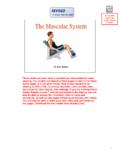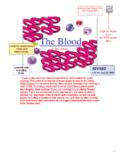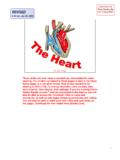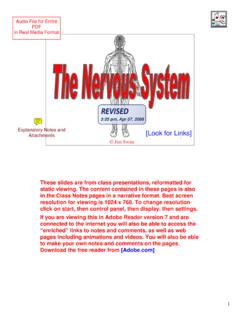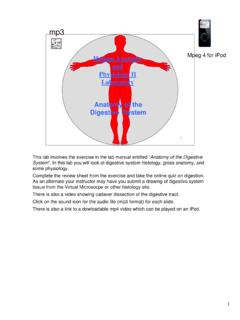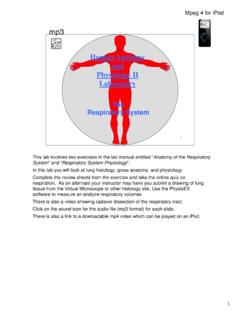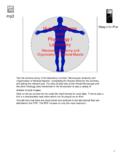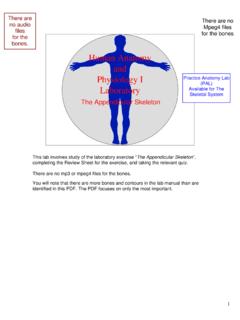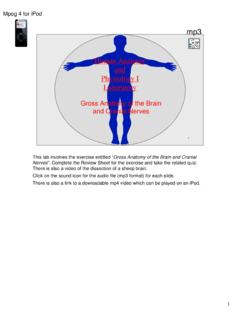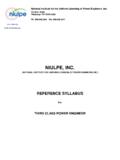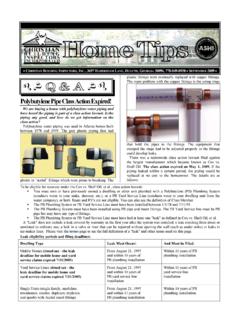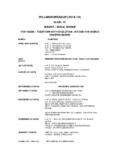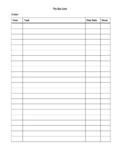Transcription of The Bones PDF - Class Videos
1 11 The BonesShort ListThese slides are from Class presentations, reformatted for static viewing. The content contained in these pages is also in the Class Notes pages in a narrative format. Best screen resolution for viewing is 1024 x 768. To change resolution click on start, then control panel, then display, then settings. If you are viewing this in Adobe Reader version 7 and are connected to the internet you will also be able to access the enriched links to notes and comments, as well as web pages including animations and Videos . You will also be able to make your own notes and comments on the pages. Download the free reader from [ ]22 Types of Bones1) Long Bones Bones of the upper and lower arms and legs as well as the metacarpals and ) flat Bones sternum, ribs, scapulae, cranium3) short Bones carpals and tarsals4) irregular Bones vertebrae5) sesamoid Bones patellae33 Skeletal Divisions1) Axial skeleton skull, sternum, ribs, and vertebrae (including sacrum)2) Appendicular skeleton Bones of the pectoral and pelvic girdles and of the arms, legs, wrists, hands, ankles, and aFrontal boneParietal boneOccipital boneTemporal boneNasal boneMaxilla Mandible ZygomaticboneSphenoid boneFrontal (coronal) sutureSquamosal(temporal) sutureOccipital (lamdoidal) sutureImportant.
2 The mastoid process(important site for attachment of muscles such as the sternocleidomastoid), the external acoustic meatus(opening into the parts of the ear), the articulation of the temporal bone and mandible ( the TMJ), and the zygomatic arch, all on the temporal BoneMastoid processStyloid processZygomaticprocess (arch)External acoustic meatus66 Tempero-mandibular JointTMJ disorder inflammation which causes pain, disorder usually occurs in young people and disappears as the Bones mature. In older adults it results mostly from teeth grinding and clenching and can be corrected with behavior adaptation or oral bonesOccipital boneSagittal (longitudinal) sutureLambdoidal sutureWormian (sutural) bones88 Frontal boneZygomaticboneMaxilla Mandible Nasal bonesPerpendicular plate of ethmoidNasal conchaeNote the nasal Bones only make up a small portion of the bridge of the nose, most of the external nose is cartilage.
3 And most of the nasal cavity is composed of parts of the ethmoid bone . 99 Ethmoid BonePerpendicular plateCrista galliCribriformplateEthmoid sinusesThe cribriform plateallows the nerves for smell to pass from the olfactory receptors in the nasal mucosa to the olfactory bulb of the brain which lies directly plateFrontal boneOccipital boneTemporal boneSphenoid boneSella turcicaNote the upper part of the ethmoid bone in the floor of the cranial cavity. The sella turcicahouses the pituitary turcicaSphenoid sinusEthmoid boneNasal boneNasal cartilageVomer bonePalatine boneMaxilla Medial View of Nasal CavityBones seen here which contribute to the boundaries of the nasal cavity: sphenoid bone , ethmoid bone , vomer bone , palatine bone , palatine processof the Wall of Nasal CavitySella turcicaSphenoid sinusEthmoid boneNasal boneNasal conchaePalatine boneMaxilla The nasal conchae increase the surface area for the air to pass across the mucosa and be warmed and BoneSella turcica contains the pituitary glandSometimes called the bat-shaped bone 1414 Paranasal SinusesFrontal sinusEthmoid air cellsMaxillary sinusSphenoid sinus1515 Sphenoid sinusFrontal sinusEthmoid air cellsMaxillary sinusSinuses must drain from one to another and into the nasal cavity to maintain open passages for equilibration of pressure.
4 When the mucosa swells and pressure is unable to equilibrate sinus pain condylesForamen magnum1717 The Atlas (C1)Articulation of occipital condylesThe occipital condyles sit atop the articular surfaces of the atlas producing a condylar jointwhich allows flexion and extension of the Axis (C2)Spinous process (spine)Dens (odontoidprocess)The atlas and head rotates around the odontoid processof the vertebrae = C1-C7 Thoracic = T1-T12 Lumbar = = 5 fusedCoccyx = 3 to 5 fusedExaggerated thoracic curvature = kyphosisExaggerated lumbar curvature = lordosisExaggerated lateral curvature = scoliosis2020 Thoracic VertebraParts to know: body, vertebral foramen, vertebral arch, lamina (part of the arch), transverse process, spinous process (spine).
5 2121 Many of the vertebral ligaments are elastic to provide flexibility. The intervertebral disks are fibrocartilage, but with variations between the nucleus pulposusin the center and the annulus fibrosusaround the outer nucleus pulposus(pulpy center) acts to absorb shock, while the annulus fibrosus(fibrous ring) holds the disk in place. Uneven pressure placed on the disk from improper lifting, etc. can cause the nucleus to rupture through the fibrous ring, called a herniated disk. This can put pressure on the nearby nerve roots, causing pain. Removal of a portion of the lamina(laminectomy) is sometimes done to relieve pressure on the spinal nerves when a disk Sacrum (dorsal view)Figure of sacroiliac jointNerve roots pass through the foramina between the processes of the 5 vertebrae which have fused to produce the the three Bones of the sternum: the manubrium, the body(or gladiolus), and the xiphoidprocess.
6 The xiphoid process usually remains cartilaginous. Ten of the twelve pair of ribs attach to cartilages, the costal cartilages, which attach to the Clavicle Scapula Acromion processCoracoid processHumerusHead of humerusGreater tubercleBicipital grooveLesser tubercleGlenoid fossaThe shoulder is movable due to flexible fibrous joints between the scapula and clavicle and bony support is minimal. Because of this a muscle group called the rotator cuff as well as other muscles are the main support for the fossaSupraspinous fossaGlenoid fossaSubscapularfossaSpine of scapulaMuscles pass through the fossas above and below the scapular spine, as well as the fossa on its anterior surface. These muscles are part of the rotator Shoulder, Ant. Viewglenoid fossaNotice the shallowness of the glenoid fossa.
7 For this reason it requires muscular support in the form of the rotator cuff. Also note the dark space in the radiograph where the soft tissues are distal end of the humerus has two important processes: the capitulumwhich articulates with the head of the radius, and the trochleawhich articulates with the trochlear notchof the ulna. 2929 The joint formed by articulation of the radius with the capitulum is a pivot jointwhich allows rotation of the radius to produce supinationand pronationof the hand. The joint between the trochlea and trochlear notch is a hinge joint which permits flexionand extensionof the the nomenclature of the metacarpalsand pelvic bone is properly terms the os coxaeor coxal bone (don t confuse it with the coccyx) and is comprised of three separate three coxal Bones unite at the acetabulum(acetabular fossa) which is the socket for the Joint RadiographAcetabular fossaHead of the femurIliumFemur IschiumPubis The hip has much more structural support through the deep socket of the distal end of the femur has the condyles, which articulate with the condyles of the tibia at the knee joint.
8 Note the patellar surface of the tibia which articulates with the
